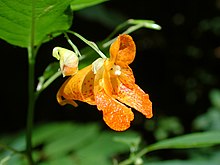Asterids
| Asterids Temporal range: [1]
| |
|---|---|

| |
| Impatiens capensis (Ericales) | |

| |
| Oregano from Lamiales | |
| Scientific classification | |
| Kingdom: | Plantae |
| Clade: | Tracheophytes |
| Clade: | Angiosperms |
| Clade: | Eudicots |
| Clade: | Core eudicots
|
| Clade: | Superasterids |
| Clade: | Asterids |
| Clades | |
| |
In the
monophyletic group). Asterids is the largest group of flowering plants, with more than 80,000 species, about a third of the total flowering plant species.[2][3] Well-known plants in this clade include the common daisy, forget-me-nots, nightshades (including potatoes, eggplants, tomatoes, chili peppers and tobacco), the common sunflower, petunias, yacon, morning glory, lettuce, sweet potato, coffee, lavender, lilac, olive, jasmine, honeysuckle, ash tree, teak, snapdragon, sesame, psyllium, garden sage, table herbs such as mint, basil, and rosemary, and rainforest trees such as Brazil nut
.
Most of the taxa belonging to this clade had been referred to as
ICBN
.
History
Genetic analysis carried out after
In the APG III system, the following clades were renamed:
Phylogeny
The phylogenetic tree presented hereinafter has been proposed by the APG IV project.[3]
| asterids |
| ||||||||||||||||||||||||||||||||||||||||||||||||||||||||||||||||||||||||||||||||||||
Subdivision
Lamiids
The lamiid subclade consists of about 40,000 species and account for about 15% of angiosperm diversity, characterized in general by superior
drupaceous and often single-seeded.[6]
Campanulids
This section is empty. You can help by adding to it. (October 2023) |
See also
- List of lamiid families
- List of basal asterid families
References
- S2CID 253521093.
- S2CID 41752744.
- ^ .
- ^ .
- ^ hdl:10654/18083.
- ^ Stull et al 2015.
Bibliography
- Stull, Gregory W.; Duno de Stefano, Rodrigo; PMID 26507112.
External links
 Media related to Asterids at Wikimedia Commons
Media related to Asterids at Wikimedia Commons- Asterids in Stevens, P. F. (2001 onwards). Angiosperm Phylogeny Website. Version 7, May 2006.
